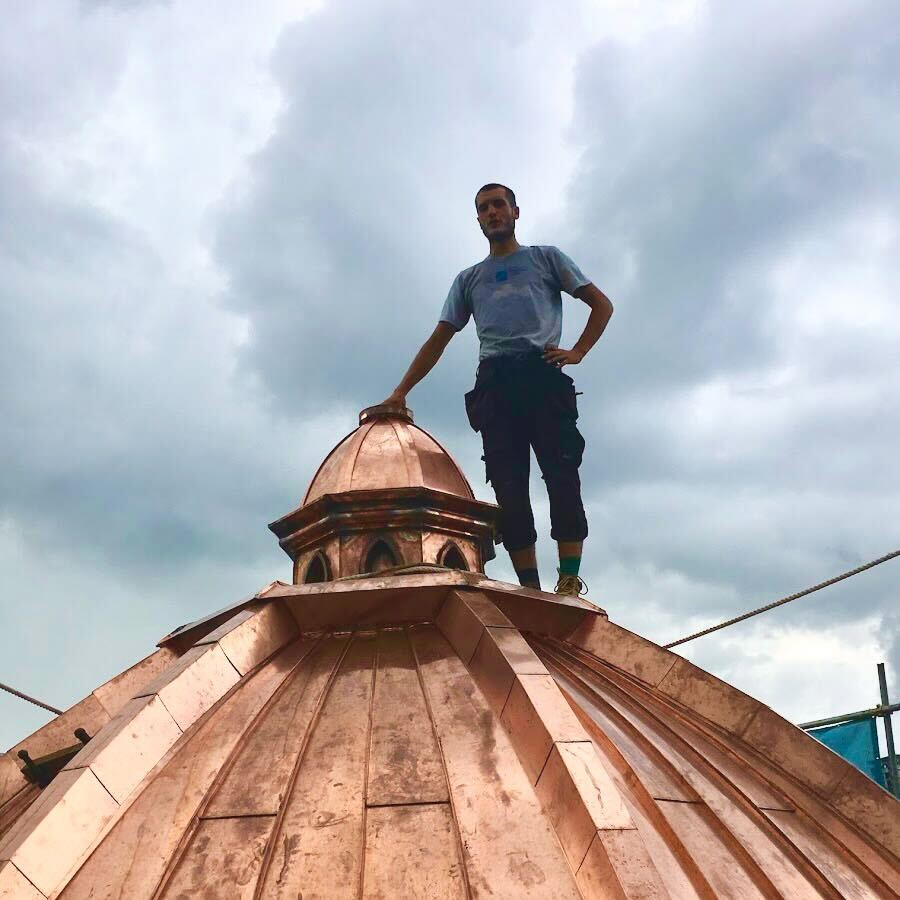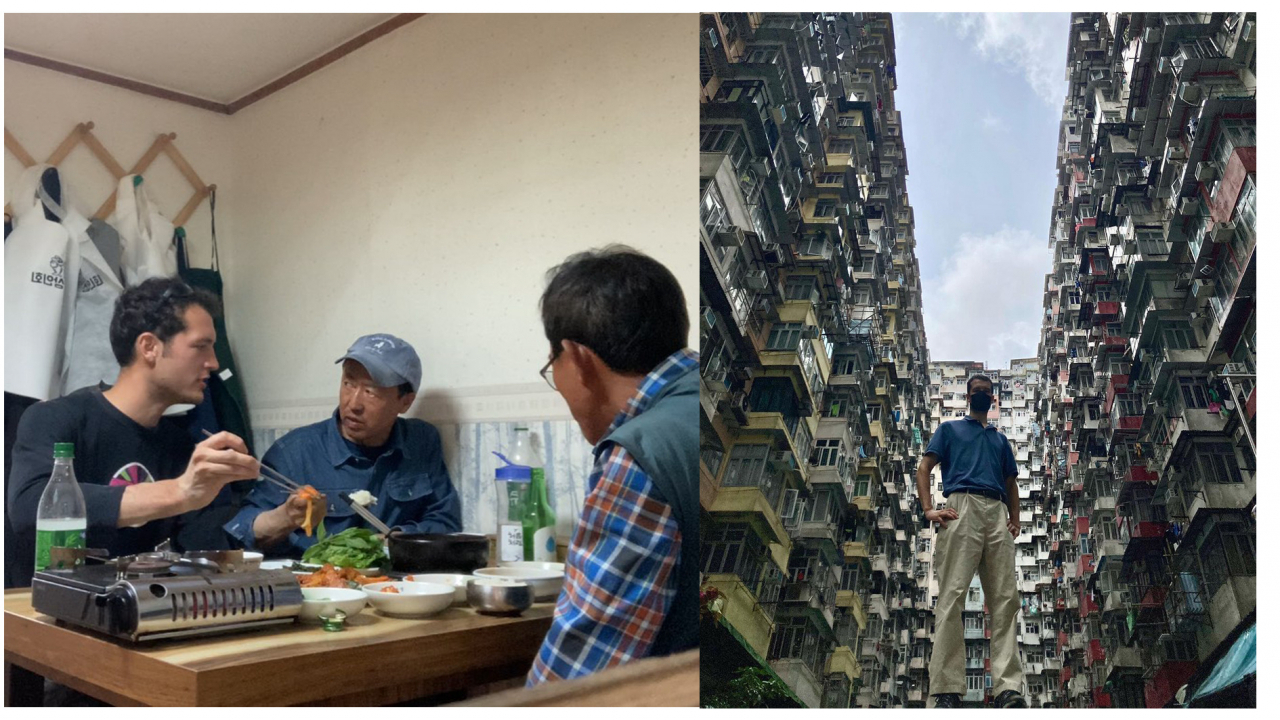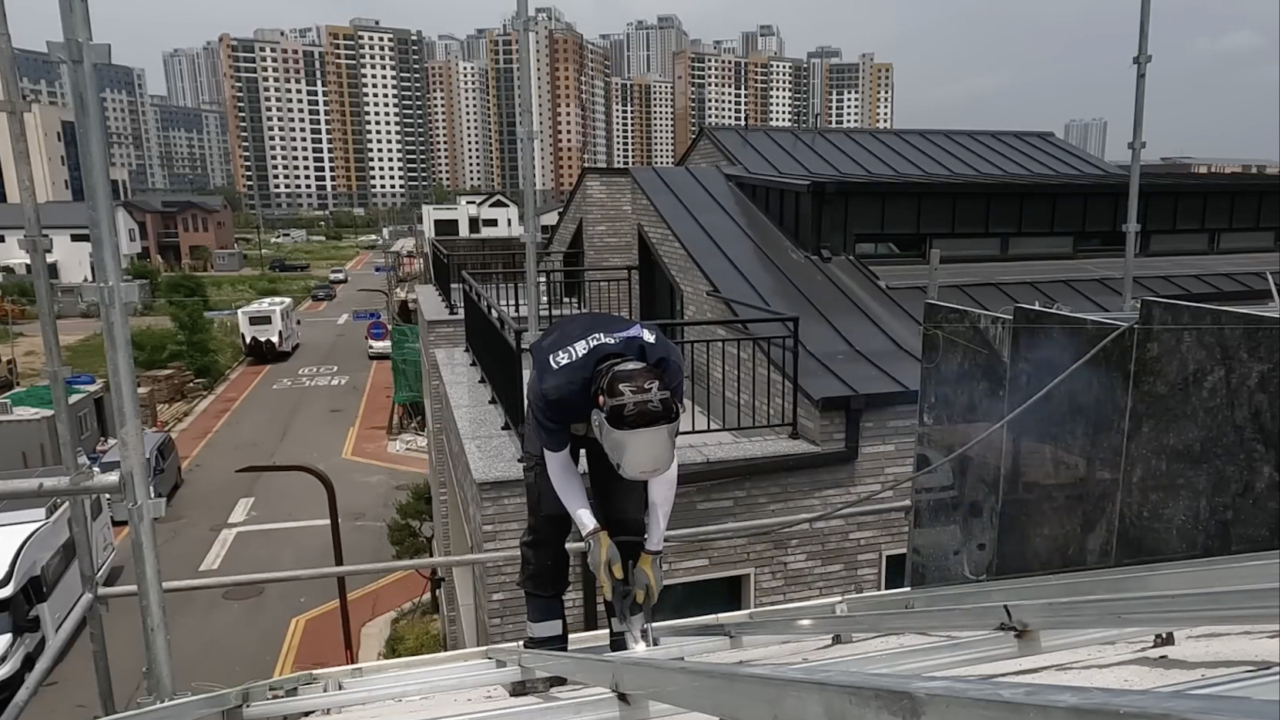From artisan to 'foreign laborer:' a French craftsman's take on Korea's construction scene
By Kim Soo-youngPublished : Nov. 3, 2023 - 16:42
Lionel Mathieu, a roofing craftsman from France, is on a unique journey within South Korea's construction scene, quietly leaving his mark.
Mathieu's path to learning the craft of roof construction began working with his hands at home at the age of 14, and at 15 led him to join Compagnons du Devoir, a combined work-study program educating over 30 types of artisans and craftsmen, dating back to the Middle Ages in France.

Through the formative program, Mathieu was able to learn from fellow craftsmen while undertaking eight years of extensive training across France, specializing in roof construction and handling zinc as a building material. Building on his training, he then had the chance to participate in repairing the roof of the Louvre Museum in Paris.
Mathieu's path since has taken him to diverse landscapes: from Australia to Hong Kong, to Singapore and now Korea.

After marrying a Korean he met in France, the couple decided to make the move here three years ago. However, despite his extensive qualifications and decades of experience, Mathieu has faced unexpected challenges seeking employment and working in Korea's construction sector.
“When I tried to look for work, I had to manage the whole game by myself. Nobody was waiting for me. Even though I had enough experience and qualifications, none of them wanted to take the risk of hiring me,” he said.
Eventually, he secured a position with a Korean construction company that acknowledged his qualifications and background, and that allowed him to start working as a freelancer in building here.

Striking disparities in Korea’s building field
As he immersed himself in his work here, Mathieu couldn't help but notice a number of striking disparities between the cultures of the building field in France and Korea. The perception of construction work in Korea was vastly different from its perception in France, which reveres it as the profession of highly skilled artisans and craftsmen.
"In France, my focus primarily centered on the roofing. However, here in Korea, most of my colleagues gained their experience not from formal education at an architecture school but from years of on-site work. Companies (here) undertake a broader spectrum of construction-related work. At times, I miss the work style and quality I experienced in France," he said.
The socioeconomic composition of those working on construction sites here also presents a major contrast to what Mathieu experienced in France. "From working hours to wages, working as a construction worker in Korea was quite different from the way I had worked so far," Mathieu said.
As a freelancer here, his work hours are irregular, and he receives significantly less compensation for his work here than he received working on a full-time basis in France. Freelancers as well as other irregularly hired workers of foreign nationality do not have access to basic state support, such as enrollment in employment insurance, worker's compensation insurance and participation in the national pension plan.
“If I didn't have a marriage (migrant) visa, I wouldn’t be able to live the way I do now," Mathieu shared.
Reflecting on the composition of the construction sector workforce, Mathieu also remarked on the age disparity he noticed in the field here.
“During the last three years, I have primarily worked with older individuals. Most of my colleagues are around 60 years old. It is quite distinct from France, where the average age of construction workers ranges from 30 to 50 years old. People typically start their careers at 18. I rarely encounter young people in the construction industry here, and I worry about who will fill the void when the current workforce retires," he said.
Mathieu has also met many other foreign workers on Korea's construction sites. According to a report published by the Construction Workers' Deduction Association, the number of foreign workers employed at construction sites as of this March reached 109,865. This figure accounts for 14.8 percent of Korea's total construction workers.
Despite their growing presence and necessity, Mathieu encountered a prevailing narrative of Korean nationals casting construction workers of foreign nationality as "oenoja" -- a portmanteau of the words for "foreign laborer" in Korean -- in a derogatory way.
"The term ‘oenoja’ carries an undertone of skepticism, implying a lack of credible expertise and the narrative of enduring hardship," he said.
As he too was labeled a “oenoja,” Mathieu could not escape from this stereotype. He was often asked, “Why do you do that kind of job? Why don’t you teach French instead?”
“However, we, as construction workers, take immense pride in our craft and possess a wealth of professional skills. We deserve to be acknowledged as 'jang-in’ (master craftsmen)," he emphasized, calling for the reevaluation of such stereotypes.
Undeterred by such sentiments, Mathieu sees his life in Korea as an extension of his craft. Mathieu runs his own YouTube channel to show that there indeed are artisans passionate about architecture and building living in Korea. He recently took another bold leap by founding his own building company. His vision is to infuse the industry with specialized skills and a fresh influx of youthful talent, aiming to make a transformative impact on Korea's building field.
“I take my current life as a challenge. I think I can bring something new to the Korean construction site,” he said.
For more insights into Lionel Mathieu's daily life and work, Korean slang commonly used in the construction field and tips on finding second-hand items here, watch the full interview with him on The Korea Herald's YouTube channel.
More from Headlines
-
![NewsletterSubscribe
Start your day with a roundup of key stories from The Korea Herald with news and comment on all that’s happening in Korea.
[Robert J. Fouser] After the National Assembly election
1 out 3 Koreans live alone, family types becoming div](//res.heraldm.com/phpwas/restmb_idxmake.php?idx=652&simg=/content/image/2024/04/27/20240427050050_0.jpg&u=20240427175628) NewsletterSubscribe Start your day with a roundup of key stories from The Korea Herald with news and comment on all that’s happening in Korea. [Robert J. Fouser] After the National Assembly election 1 out 3 Koreans live alone, family types becoming div
NewsletterSubscribe Start your day with a roundup of key stories from The Korea Herald with news and comment on all that’s happening in Korea. [Robert J. Fouser] After the National Assembly election 1 out 3 Koreans live alone, family types becoming div -
 Meeting of president, opposition chief set to finally happen
Meeting of president, opposition chief set to finally happen -
 South Korea to launch space security center under spy agency
South Korea to launch space security center under spy agency













![NewsletterSubscribe
Start your day with a roundup of key stories from The Korea Herald with news and comment on all that’s happening in Korea.
[Robert J. Fouser] After the National Assembly election
1 out 3 Koreans live alone, family types becoming div](http://res.heraldm.com/phpwas/restmb_idxmake.php?idx=652&simg=/content/image/2024/04/27/20240427050050_0.jpg&u=20240427175628)




